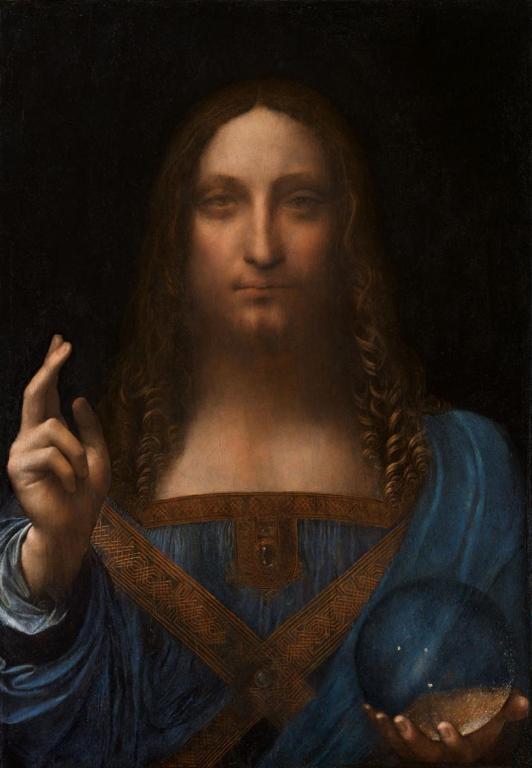The New Da Vinci: “The Savior of the World”
There is a newly discovered and authenticated painting by Leonardo da Vinci, a painting of Jesus Christ entitled “Savior of the World.”
It sold at auction Wednesday for $450,312,500–the highest priced painting ever sold at auction–to an unidentified buyer
. (The previous record was $179,364,992 for a Picasso.) In 1958 the painting was sold for the equivalent of $125.
It was known that Leonardo painted a picture of Jesus for the King of France between 1506 and 1513, but it had been presumed to be lost. A number of copies of the painting, however, were made by other artists. This painting was assumed to have been one of the copies.
Heavily over-painted, to cover damage to the image over the centuries, the painting was sent to an expert for restoration. When the added layers of paint were removed, it was evident that an early version of the painting showed Christ’s thumb in a different position, which the artist then changed. The restorer realized that a copy would not have originally changed the position of the thumb, and, indeed, all other copies preserve the new version. There are similar details showing the artist’s revision of the work that are not to be found in copies.
Also, the restorer found that the painting was created with multiple layers of very thin, translucent paint, which was Leonardo’s technique. X-rays also detected a handprint that had smeared different colors of paint together, another characteristic practice of Leonardo that is seldom found in other artists.
Other evidence includes the material (oil on walnut), the way the painting renders the ringlets of hair and the knot work of the robe, as well as the highly detailed hands–all of which are similar to other Leonardo da Vinci paintings.
After extensive further study, Leonardo experts authenticated the painting as one of only 16 surviving works by the Renaissance polymath.
Some art critics are disputing the authenticity of the painting on various stylistic grounds, but there is considerable weight of scholarship on the other side.
See the Wikipedia entry for the painting, which summarizes the evidence, the disputes, and the history of the work.
I would add that the face reminds me of other da Vinci faces, with the enigmatic expression reminding me of the “Mona Lisa.”
Painting a portrait of Jesus Christ, one that is spiritually and theologically satisfying, is extremely difficult. How can an artist suggest the Incarnation? Typically, a painting of Jesus can go wrong by evoking His humanity, but missing any suggestion of His divinity. Thus we have lots of renditions of Jesus that try to show a compassionate human being, but end up being sentimental, maudlin, or effeminate.
But other artists go wrong in the other direction. Christ is depicted as divine, but not persuasively human. I think of the scowling but majestic paintings, so favored in Medieval and Renaissance art, of Christ Pantocrator, judging the world.
But the very best depictions of Christ evoke both His humanity and His divinity.
This one, in my opinion, measures up. Christ here is depicted not as an abstraction but with the realism of the Incarnation. And yet his expression is otherworldly, a mystery.
He gazes at us directly. One skeptic about the painting says that Leonardo never painted such face-on poses. Yes, but this is Jesus Christ, looking right through us, confronting us, seeing into our souls!
And he is holding a clear orb, symbolizing the world that He has saved. Another skeptic says that the orb mustn’t be by Leonardo because it isn’t realistic in distorting the light like a true crystal ball would. But this isn’t a crystal ball, but the universe, which Jesus holds in his hand! So the artist renders it mysteriously.

And the subject, as revealed by the title, intrigues me. (Titles add a word to the image and thus can convey their meanings.) Salvator Mundi. The Savior of the World.
We see here not Christ as judge, but Christ as Savior.
Luther would make that same emphasis a few years later, but the Reformation was already in the air.
Readmore: Christian painting
Comments
Post a Comment